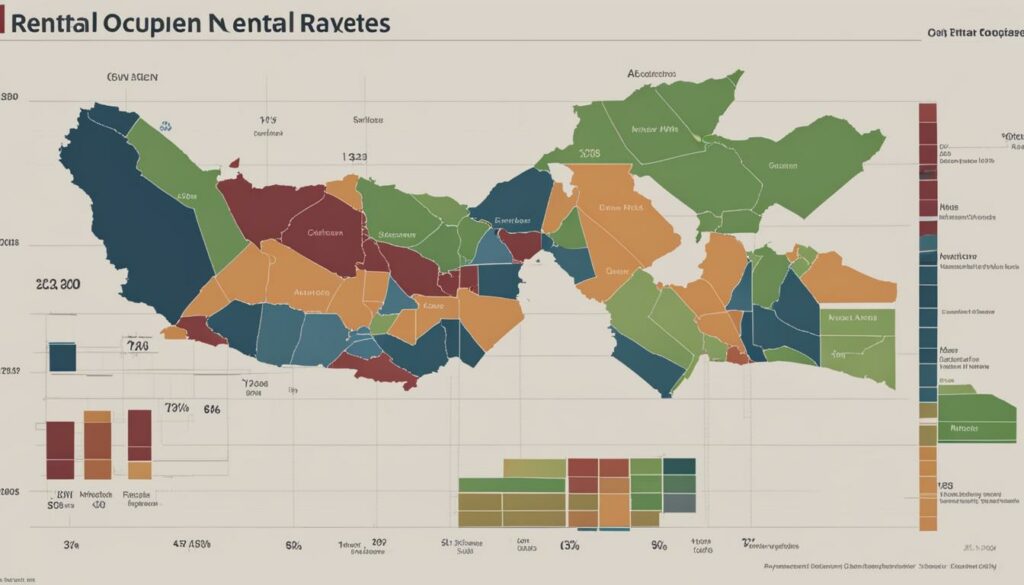Expert Guide to Rental Market Analysis – Your Key to Success
Welcome to my expert guide to rental market analysis. As a professional in the real estate industry, I know the importance of understanding the rental market trends and incorporating them into successful business strategies. In this guide, I will share my extensive knowledge of rental market analysis techniques and provide valuable insights into how to navigate the ever-changing landscape of the real estate market.
Whether you are a seasoned investor or just starting, rental market analysis should be an integral part of your business strategy. By analyzing rental market trends, you can make informed decisions, anticipate future demand, and maximize the profitability of your rental properties.
Key Takeaways:
- Understanding rental market trends is crucial for success in the real estate industry.
- Rental market analysis is an essential tool for making informed decisions and maximizing rental property profitability.
- The fundamentals of rental market analysis include rental property analysis, market analysis reports, and thorough rental market research.
- Accurate and up-to-date rental market data is crucial for effective rental market analysis.
- By analyzing rental market trends, you can anticipate future demand and develop pricing strategies that maximize your rental income.
Understanding Rental Market Analysis
As a real estate professional, understanding the fundamentals of rental market analysis is essential to succeed in the rental market. It involves conducting rental property analysis, generating market analysis reports, and conducting thorough rental market research to make informed decisions.
The Importance of Rental Property Analysis
Rental property analysis involves evaluating the potential of a rental property. It includes assessing the property’s location, amenities, condition, and rental income to understand its value and potential profitability. By conducting rental property analysis, you can determine if the property is worth investing in and what changes you need to make to improve its profitability.
Market Analysis Reports
Market analysis reports provide comprehensive insights into the rental market, enabling you to make informed decisions. It includes data on rental market trends, rental property analysis, and rental market research. By analyzing market analysis reports, you can stay ahead of your competitors and anticipate market trends.
Thorough Rental Market Research
Conducting thorough rental market research involves gathering data on rental market conditions, such as vacancy rates, rental rates, and demographics. This information is essential to make informed decisions on pricing strategies, marketing efforts, and property upgrades.
Understanding rental property analysis, generating market analysis reports, and conducting thorough rental market research are essential components of rental market analysis.
“To effectively navigate the rental market, it is essential to understand the fundamentals of rental market analysis.”
Gathering Rental Market Data
Accurate rental market data is crucial for making informed decisions in the real estate industry. Without reliable data, it can be challenging to understand rental market trends, anticipate demand, and develop effective pricing strategies.
There are various sources of rental market data, including government agencies, real estate associations, and rental listing platforms. When gathering rental market data, it is essential to focus on the most relevant and up-to-date statistics. Some of the common rental market statistics to consider include:
| Rental Market Data | Description |
|---|---|
| Vacancy Rates | The percentage of rental units that are currently unoccupied. |
| Average Rental Rates | The average monthly rent for a specific type of rental property in a particular location. |
| Rental Yield | The return on investment (ROI) generated by a rental property. |
| Rental Market Growth | The percentage change in the number of rental properties in a specific location over a particular period. |
Interpreting rental market data can be complex, particularly as different factors can influence each statistic. For example, a low vacancy rate may indicate high demand for rental properties, but it can also result from limited new construction or restrictive housing policies.
Using Rental Market Data to Make Informed Decisions
By gathering and interpreting rental market data, you can gain valuable insights into the rental market trends and make informed decisions about your rental properties.
For example, if the rental market data indicates high demand for rental properties, you may consider increasing your rental rates to maximize your rental income. Alternatively, if the rental market data indicates a high vacancy rate, you may lower your rental rates or offer incentives to attract more tenants.
Remember, rental market data is not static and can change rapidly, so it is essential to continually update and monitor your rental market research.
“Accurate and up-to-date rental market data is the bedrock of any successful rental market analysis.”
Analyzing Rental Market Trends and Making Accurate Forecasts
As with any market, rental market trends are constantly evolving, and it is crucial to stay ahead of the curve. By analyzing rental market trends, you can anticipate changes in demand and pricing strategies to optimize your rental property investments. Here’s a breakdown of the process:
- Collect and analyze data: Gathering accurate rental market data is the first step in analyzing market trends. Look at key indicators such as vacancy rates, rent prices, and population growth.
- Identify patterns and anomalies: Once you have collected the data, you need to identify patterns and anomalies. Are rent prices increasing or decreasing? Is there a surplus of rental properties in a particular area?
- Predict future trends: Using the data and patterns you have identified, make educated predictions on future rental market trends. Will there be an increase in demand for rental properties in a particular area, or will it decrease?
It is also important to stay up-to-date with rental market forecasts provided by industry experts. These forecasts take into account economic and demographic trends, which can significantly impact the rental market.
The table above showcases rental market trends in three different cities over the past three years. As you can see, while there have been fluctuations in each city, overall, rent prices have been steadily increasing. This information can be used to predict future trends and adjust pricing strategies accordingly.
“The rental market forecast for the next year predicts a decrease in demand for rental properties due to the economic downturn.”
By keeping a pulse on rental market trends and incorporating them into your market analysis, you can make informed decisions and stay ahead of the competition.
Factors Affecting the Rental Market
As a real estate investor or property manager, it is crucial to understand the various factors that can impact the rental market. By incorporating these factors into your rental market analysis, you can make informed decisions about pricing strategies, marketing efforts, and overall portfolio management. Here are some of the key factors that can affect the rental market:
Economic Conditions
The health of the economy can have a significant impact on the rental market. During times of economic growth and low unemployment rates, demand for rental properties may increase as more individuals have the means to afford rent. Conversely, during times of economic recession, demand for rental properties may decrease as individuals struggle to find or maintain employment.
Population Growth
Population growth in a particular area can greatly impact the rental market. A growing population may lead to increased demand for rental properties as more individuals require housing. Additionally, population growth can impact the supply of rental properties as developers may seek to capitalize on growing demand by building more rental units.
Housing Policies
The policies and regulations surrounding the housing market can also affect the rental market. For example, rent control policies may limit the rental income potential for property owners, while programs that incentivize affordable housing may increase the availability of rental properties in certain areas.
Real Estate Market Analysis
Conducting regular real estate market analysis can provide valuable insights into the factors affecting the rental market. By staying up to date on market trends and monitoring changes in economic conditions and housing policies, you can adjust your rental market analysis accordingly and stay ahead of the competition.

Overall, understanding the factors that impact the rental market is essential for conducting comprehensive rental market analysis. By incorporating these factors into your analysis, you can make informed decisions about pricing strategies, marketing efforts, and portfolio management, ultimately resulting in greater success in the real estate industry.
Conducting Competitive Analysis
When conducting rental market analysis, it is essential to assess the competition in the market. Knowing your competitors’ strengths and weaknesses can help you identify your unique selling points and optimize your rental property investments. The following are the steps to conduct a comprehensive competitive analysis:
Collect Data
The first step in conducting a competitive analysis is to gather data on the properties in your market. This data includes rental rates, property amenities, property age, and location. You can obtain this information by visiting competitor websites, searching online rental listings, and conducting on-site visits.
Once you have collected the necessary data, organize it into a table to help you compare and contrast each competitor’s strengths and weaknesses.
| Competitor | Rental Rate | Amenities | Property Age | Location |
|---|---|---|---|---|
| Property A | $1,500/month | Gym, Pool, Pet-Friendly | 2 years | Downtown |
| Property B | $1,700/month | Gym, Pool, Pet-Friendly | 5 years | Suburban |
| Property C | $1,200/month | No amenities | 10 years | Rural |
In the table above, Property A and Property B are direct competitors with comparable amenities and location, but Property B charges a higher rental rate. Property C, on the other hand, is less expensive, but lacks amenities and is located in a rural area.
Analyze the Data
After collecting and organizing the data, the next step is to analyze it. This analysis should identify your competitor’s strengths and weaknesses.
For instance, in the table above, Property A and Property B both have similar amenities and locations, but Property B charges a higher rental rate. This suggests that Property A may be a better value for potential renters.
Identify Your Unique Selling Points
Analyzing the competition can also help you identify your unique selling points. These are the features and benefits of your rental properties that set them apart from the competition.
For instance, if most of your competitors charge extra fees for pet-friendly units, but you offer pet-friendly units at no additional charge, this can be a unique selling point.
In conclusion, conducting a competitive analysis is essential for rental market analysis and rental property analysis. It can help you identify your unique selling points, optimize your pricing strategies and maximize your rental property investments.
Applying Rental Market Analysis to Pricing Strategies
As a real estate investor, it’s essential to develop effective pricing strategies for your rental properties. To achieve this, you need to understand how rental market analysis applies to pricing techniques.
One crucial component of rental market analysis is rental property analysis, which involves assessing the value of your rental property and comparing it to similar properties in the same location. By conducting rental property analysis, you can determine appropriate rental rates and develop effective strategies for pricing your rental properties.
Another critical aspect of rental market analysis is market analysis reports. These reports provide in-depth insights into current rental market trends, including supply and demand, vacancy rates, and rental rates. By analyzing these trends, you can develop pricing strategies that maximize your rental income and attract high-quality tenants.
Example pricing strategy:
| Rental Property | Location | Monthly Rent |
|---|---|---|
| Apartment A | Downtown | $2,500 |
| Apartment B | Suburbs | $1,800 |
| Apartment C | Rural | $1,200 |
In this example, rental market analysis has been applied in setting rental rates for three apartments in different locations. Apartment A, located in downtown, commands the highest monthly rent due to high demand and limited supply in that area. Apartment B, located in the suburbs, has a slightly lower monthly rent due to lower demand and higher supply. Apartment C, located in a rural area, has the lowest monthly rent because of the low demand and ample supply in that location.
By applying rental market analysis to pricing strategies, you can maximize your rental income and attract high-quality tenants. It’s essential to conduct regular rental market research and analysis to stay ahead of market trends and adjust your pricing strategies accordingly.

Implementing Rental Market Analysis in Portfolio Management
As a real estate investor, it is essential to implement rental market analysis techniques in portfolio management. By doing so, you can optimize the performance and growth of your rental properties, ensuring long-term success in the rental market.
One way to implement rental market analysis is to regularly conduct real estate market analysis reports for each rental property in your portfolio. This report should include details on the property’s location, size, amenities, and rental history. By analyzing this data, you can identify areas for improvement and opportunities for growth, such as raising rents or adding value to the property through renovations or upgrades.
Another crucial aspect of portfolio management is ongoing rental market research. This involves monitoring rental market trends, identifying patterns, and making accurate market forecasts. By doing so, you can anticipate changes in demand and pricing and adjust your portfolio accordingly, ensuring your properties remain competitive and profitable.
Table: Comparison of Rental Properties in Portfolio
| Property Name | Location | Size (sq. ft.) | Monthly Rent |
|---|---|---|---|
| The Cambridge | Midtown Manhattan | 750 | $4,000 |
| The Chelsea | Chelsea, Manhattan | 900 | $3,500 |
| The Greenwich | Greenwich Village, Manhattan | 1,200 | $5,000 |
For example, the table above shows a comparison of three rental properties in a portfolio in Manhattan. By analyzing the data, you can see that The Cambridge has the highest monthly rent, despite being the smallest property. This suggests that The Cambridge may be priced too high, and adjustments should be made to remain competitive in the market.
Furthermore, implementing rental market analysis in portfolio management can help you identify which properties are performing well and which ones may need attention. By analyzing key performance indicators such as occupancy rates and rental income, you can adjust your investments accordingly, ensuring maximum returns and optimal portfolio growth.
In conclusion, implementing rental market analysis techniques in portfolio management is essential for success in the real estate industry. Regularly conducting real estate market analysis reports, ongoing rental market research, and analyzing key performance indicators can help you make informed decisions and stay ahead of the competition in the rental market.
Conclusion
As a professional in the real estate industry, I cannot stress enough the importance of rental market analysis in achieving success. Through the expert guide to rental market analysis provided in this article, you can gain a thorough understanding of the fundamentals of rental property analysis, market analysis reports, and rental market research.
Accurate and up-to-date rental market data is essential in staying ahead of the competition. By effectively analyzing rental market trends and making accurate market forecasts, you can anticipate future demand and optimize your rental property investments.
Various factors, such as economic conditions, population growth, and housing policies, can impact the rental market. Understanding and incorporating these factors into your market analysis can help you make informed decisions and develop effective pricing strategies to maximize your rental income.
Conducting competitive analysis in the rental market can help identify your unique selling points and position your rental properties effectively. Applying rental market analysis techniques to portfolio management can ensure optimal performance and growth of your rental property investments.
In conclusion, by understanding and applying rental market analysis techniques, you can adapt to market trends, make informed decisions, and maximize the profitability of your rental properties. So, start incorporating rental market analysis into your business strategy today, and take your real estate business to new heights!
FAQ
What is rental market analysis?
Rental market analysis is the process of evaluating and interpreting data and trends in the rental market to make informed decisions in the real estate industry. It involves analyzing factors such as rental prices, occupancy rates, market demand, and competition in order to optimize rental property investments.
Why is rental market analysis important?
Rental market analysis is crucial because it provides valuable insights into the ever-changing landscape of the rental market. It allows real estate professionals to understand market trends, anticipate demand, and make informed decisions regarding rental property acquisitions, pricing strategies, and portfolio management.
How do I gather rental market data?
Gathering rental market data involves researching and collecting information from various sources such as real estate databases, rental listings, government reports, and industry publications. It is important to gather accurate and up-to-date data to ensure the reliability of your rental market analysis.
How do I analyze rental market trends?
Analyzing rental market trends requires a thorough evaluation of historical and current data to identify patterns and forecast future market conditions. This involves monitoring factors such as rental prices, occupancy rates, population growth, and economic indicators to make accurate predictions and adjust pricing strategies accordingly.
What factors affect the rental market?
Various factors can influence the rental market, including economic conditions, population growth, housing policies, and changes in lifestyle preferences. These factors can impact demand, supply, and pricing in the rental market, so it is essential to incorporate them into your rental market analysis.
How do I conduct competitive analysis in the rental market?
Conducting competitive analysis in the rental market involves researching and evaluating similar rental properties in your target market. It includes comparing rental prices, amenities, property features, and marketing strategies to identify your unique selling points and stay ahead of your competitors.
How can rental market analysis help with pricing strategies?
Rental market analysis provides insights into market demand, competition, and tenant preferences, which are essential for developing effective pricing strategies. By understanding the rental market dynamics, you can price your rental properties competitively to attract tenants and maximize your rental income.
How can rental market analysis be applied to portfolio management?
Rental market analysis is crucial for managing a portfolio of rental properties. It helps to identify market trends, optimize rental income, and make informed decisions regarding property acquisitions and dispositions. By analyzing the rental market, you can ensure the overall performance and growth of your rental property investments.







